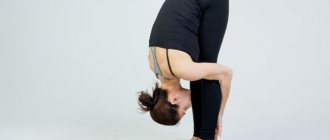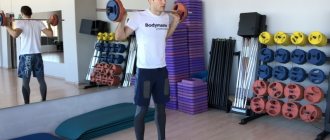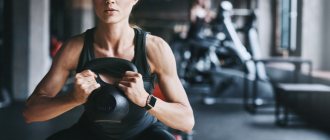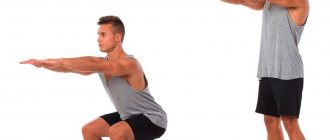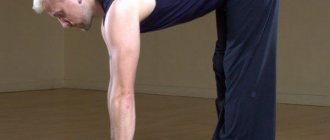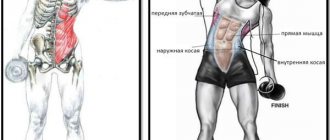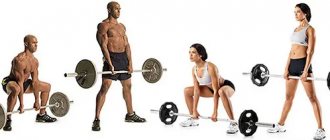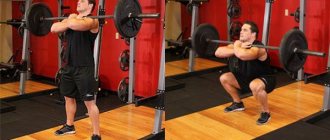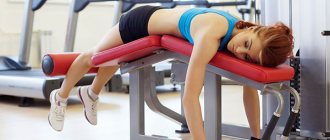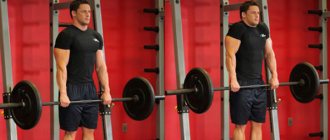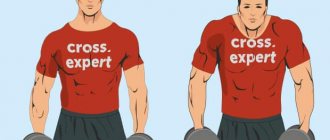Bent over with a barbell on your shoulders or “good morning” is one of the exercises that migrated into fitness from powerlifting. Triathletes borrowed it from weightlifters. In one form or another, bending with a barbell is found in kettlebell lifting, bodybuilding, and even strongman. Where they are not present is in modern halls. If you start doing good mornings, most likely the trainer on duty will come up and tell you what a dangerous and traumatic movement this is. But in reality this is not so. Bent over with a barbell on your back develops not only the long back muscles, but also the back of the thighs and buttocks. When performed correctly, the incline is no more dangerous than everyone's favorite Romanian deadlift in fitness.
In powerlifting, barbell bends are done as an auxiliary movement to the deadlift. The exercise strengthens the long back muscles and teaches stabilization of the apparatus. The development of hamstrings and buttocks in this sport is considered rather a side effect. Because bending exercises can be performed with a wide variety of weights, they can be useful for a variety of needs.
What muscles work
Main engines:
- The entire array of gluteal muscles . The exercise works the gluteus medius, minimus, and gluteus maximus muscles, but they are used to varying degrees;
- Biceps femoris - are involved in extension of the hip joint;
- Long back muscles - stabilize the body during extension, but are the main ones, since they begin movement during extension, and are involved in the work throughout the exercise.
The following are also involved as stabilizers:
- abs, arm muscles and latissimus, as well as the rhomboid muscles of the back.
- partly to maintain the vertical position of the body, the muscles of the front surface of the thighs are also involved in the work.
The calves may or may not be involved in the exercise as stabilizers. It depends on the position of the body and the depth of the bend. The width of the feet in the exercise affects the degree of involvement of the gluteal muscles. The more sumo-like the stance is, the more the exercise works to develop the glutes. If an athlete rises on his toes, straightening his body, he develops his calves too. A strong back build puts emphasis on the diamond, while a low bar puts emphasis on the lower back.
Bent-overs with a barbell on your shoulders: technique and nuances
Equipment
To perform inclines, you will need a barbell or an empty bar. For beginners, at first, one bar will be enough to work the lower back and buttocks. Gradually the weight should increase with the help of pancakes.
For better control of a heavy barbell, you can use sports gloves or talcum powder. They will not allow the projectile to slip out of your hands, which will significantly secure the “good morning” performance. You can also protect your knees with elastic bandages. They will help you cope with heavy weights.
Advantages and disadvantages of the exercise
Each movement has its pros and cons. Perhaps doing the “good morning” exercise with a barbell is not the best option for those who experience problems with the spine, but in terms of the physical development of healthy people, the exercise can bring quite a lot of benefits.
Advantages
- Working the muscles of the posterior chain in a fairly natural amplitude for them, but without grip load. This is valuable for those who want to lift a lot, and constantly perform deadlifts, bent-over rows and other exercises that develop the back and hamstrings. Moving with a weight in your hands can become a problem over time if the athlete is unable to hold the barbell without pain;
- The movement helps improve posture, as it helps to master the skill of bringing the shoulder blades to the spine and back;
- Will help develop strength in the deadlift and squat by strengthening and developing the muscles of the posterior chain;
- Helps prevent knee and lower back injuries if performed in the correct amplitude with unambitious weights;
- Develops the buttocks, strengthens and tightens them. Helps to add training volume when working on these muscles, to diversify training for those who are tired of classic squats and deadlifts;
- It can be a rehabilitation exercise after injuries to the hamstrings if performed in partial amplitude and with minimal weight;
- Eliminates blood stagnation in the pelvic organs. It is a prevention of gynecological and andrological disorders;
- It is not a difficult coordination exercise and is accessible to most athletes.
Flaws
- Requires good range of motion in the hip joint. They cannot become the basis of the training process if the amplitude is exclusively reduced. Requires stretching, cannot be performed with the so-called short hamstring;
- The movement is quite traumatic for those athletes who cannot hold the barbell firmly on their back and systematically exceed the weight;
- The exercise requires proper planning. If you use it as a “finisher,” you can get injured simply due to overworking the posterior chain. A more rational approach is to plan the deadlift and this movement as interchangeable exercises, doing the barbell incline instead of a moderately heavy deadlift, rather than as a separate heavy exercise. The movement is performed with a maximum of half and 1 rep maximum in the classic deadlift.
Recommendations and tips
Training the entire back with a barbell is possible. This universal equipment is quite effective. But in order to ensure the effectiveness and safety of training, an athlete should consider a number of recommendations:
- training should take into account the characteristics of the body. An ectomorph who wants to increase weight should stick to one plan, and someone who is losing weight should stick to another;
- Before starting classes, you need to make sure there are no contraindications. Yes, it is effective to lift your back with a barbell, but if an athlete, for example, has a curvature of the spine, it requires a special approach and the exclusion of some exercises from their training plan;
- chronic diseases not related to the back should also be taken into account. For example, you should not do heavy exercise if you have a heart condition or blood pressure problems;
- Before you start pumping your back with a barbell, it is recommended to warm up thoroughly. This will reduce the risk of sprains and other injuries;
- It’s better to pump your back not only with a barbell. Pull-ups, exercises with dumbbells and on machines will help complement the program and increase its effectiveness;
- It makes no sense to pump up muscles without following a training regimen, as well as proper nutrition. Only the right sports regime will lead to achieving results;
- training should take into account the speed of recovery of the body. For some, a week is enough, while others require much longer. Therefore, you shouldn’t do hard exercises every time, you need to alternate them with easier ones;
- changing the type of load can increase the result. It is worth thinking about combining strength training and high-repetition training. But everyone has their own combination proportions.
The main thing is that the classes are beneficial and correspond to the goals and objectives. Exercise should improve your health, not harm it.
Before pumping your back with a barbell, you should make sure that it will bring benefits. First of all, health problems that may prevent the use of such equipment are excluded. After this, a proper plan is drawn up. Classes should be varied and effective, supplemented by a regimen and proper nutrition. Only all the elements together will help achieve the desired result.
DEADLIFT. How to DEADLIFT for muscle growth. How to do it correctly to gain weight.
Execution technique
First of all, you need to master working in a safety frame. Adjust the stops so that in the lower position of the tilt with the barbell you can freely lower it onto the belay and get out from under the projectile. This will make the execution process safe. At the same time, you don’t need to place the stops too high so as not to hit the barbell against them every time. If the gym does not have such a frame, place weightlifting plates of the required height on the sides, so that you can lower the barbell on them simply by placing weight plates.
Stand up straight and set the bar at low bar squat height. In this exercise, you do not need to place the bar on the top of the trapezius, just lower it lower and “pass” the attachment point of the trapezius muscles.
The barbell is on your back, not on your shoulders:
- The barbell is removed as if doing a squat. You need to come up, position yourself in the middle of your body under the bar, bend your knees, and then straighten them, moving away from the racks;
- The shoulder blades should be retracted and stabilized, the shoulders should be pulled back and lowered;
- The feet can be placed as in a squat or a little wider;
- The toes are pointed to the sides so that when bending, the body position remains stable;
- As you inhale, the pelvis moves back and bends forward;
- Then - return the body to a neutral position, check the shoulder blades, tilt again;
- The amplitude in this exercise is individual. Those who cannot afford deep stretching should bend no more than 2/3 of the range of motion;
- Installing the rod on the racks occurs in the reverse order. First you need to carefully step back, position the bar over the safety supports, and then bend your knees and lower the barbell onto the racks.
Note: Where did the name of the exercise come from? Some individuals believe that it is a tribute to the practice of “Surya Namaskar”, where there is a forward bend. But the name actually comes from the traditions of the West Side School. The exercise was recommended for athletes to do before starting any morning workout. By the way, who cares about the “huge weights of the Westside”, strong people limited themselves to an empty bar. The exercise was done in 1 approach “until the burning sensation”, after which the morning workout could be carried out as usual.
bodymaster : Forward bends with a barbell on the shoulders “Good morning”
Tips for maximum efficiency
Every person dreams of seeing results as soon as possible. To do this, it is important to know the points that significantly increase your training efficiency:
- You should always start the complex with a warm-up, paying special attention to the muscles of the chest and back.
- The barbell should be held just below your shoulders so that all the weight is not on your back, but on your legs and buttocks.
- You should not do too many repetitions, since it is not the quantity, but the quality of the exercises that is important.
- No sudden movements, you should bend down slowly and rise smoothly.
- The neck should be an extension of the spine; you cannot look down, this provokes a rounding of the back, which leads to a violation of safety regulations.
- It is important to choose the right weight and not grab the heaviest load, as this will immediately affect your back.
- It is advisable to end the workout with stretching so that the muscles recover faster.
Bent-overs with a barbell are an extremely effective exercise that helps to work out quite problematic areas (buttocks and back of the thigh). The most important thing is to always monitor your technique to prevent injury, especially if a girl is training. Beginners should start training with an experienced trainer.
Execution options
In fact, there are not so few options as is usually assessed in fitness. Many people believe that the exercise should be done solely to develop the buttocks and hamstrings. But in reality, there are quite back-isolating options and many versions with different types of shock absorbers. We list just a few of them that are applicable to the general development of non-specialized athletes.
Bent-overs with a barbell on your shoulders while sitting
This option takes the stress off the hamstrings and buttocks. But it promotes the development of the long back muscle, and the strengthening of the latissimus and rhomboids. This variation is great for anyone with hamstring strains or knee injuries. You need to do the exercise while sitting. The bench is selected so that the buttocks are just below the kneecaps. The reason is that the movement is used not so much “for the back”, but as a special preparatory exercise for the hip joints and lower back. The bar is installed at the height for a squat, removed in the usual way, then the athlete carefully sits on the bench and bends forward.
Option with shock absorbers
A rubber band attached to the bar helps develop the upper third of the movement. This gives a good lockout in the classic deadlift and allows you to get rid of problems with not straightening quickly enough. The rubber at the bottom helps to stretch the buttocks more. When performing the exercise, shock absorbers are placed on the ends of the bar and rack to perform a squat at the bottom. The technique is common, you just need to be careful and try not to catch the racks with rubber.
Bent-overs with a barbell on a Smith machine
This variation is not liked in powerlifting because it lacks a natural range of motion. But the fixed bar is still used by those who have problems with stabilization using a regular barbell. The Smith machine variation is good for bodybuilding-oriented training. But technically it differs only in that to start you just need to rotate the bar back and thereby remove the weight from the safety stops.
In powerlifting, “narrowly targeted” versions are used with a safe bar for squats, as well as with a thick bar, whose center of gravity is shifted compared to a regular barbell. But these variations are too narrowly focused to be considered separately.
Exercise GOOD MORNING
Interesting Facts
A common name for this exercise is “good morning” . It arose due to the fact that the movement while performing bends with a barbell is reminiscent of the sun salutation that a person does immediately after waking up.
Despite the name, this exercise is most often done in the middle of the day or in the second half - this is when most athletes engage in strength training.
This exercise has been known for quite some time. Back in the 19th century, it was made by strongmen and wrestlers. In those days, strength training was very different from what it is today, but much of the knowledge about the proper organization of training to develop muscle strength was known even then.
Athletes of those times experimentally determined what exercises needed to be performed in order to achieve good results, and how they should be done. Since standing bends with a barbell can strengthen the lower back and also contribute to the development of the legs, they fit perfectly into the training program of the security forces of those years.
Common mistakes
Poor training planning
The exercise should not be on the same day as a deadlift or heavy Romanian deadlift. With a squat - maybe, but in this case the priority exercise is selected, namely the one that will be more difficult. Typically this is a squat. It is performed at the beginning.
The incline is performed with half the weight available in a classic deadlift, or even less weight. It can be performed with very minimal weights in a high-repetition mode if hypertrophy of the gluteal and hamstrings is required.
Using large scales
Exceeding the body's capabilities too significantly is always the cause of injury. Performing movements with inadequately high weights will not allow most people to progress for quite a long time. Because an athlete of this type will get injured much earlier than he begins to increase the weight on the bar.
Lumbar flexion
Amateur fitness is not an option when you really should do a backbend in the thoracic region or a backbend in the lumbar region. The more natural the position of the spine, the safer the exercise will remain. It is not recommended to arch your back to "engage your glutes" as it does not work and does not promote proper technique.
Basic mistakes in bending over with a barbell
The following mistakes are common among beginners:
- Bend your knees too much. This leads to the fact that the wrong muscles work and the exercise turns from bending into a squat.
- Round shoulders. This happens due to too much weight, under which the athlete’s body literally bends. This is very dangerous for the spine.
- Look at the floor. This mistake is also associated with lifting heavy weights - many are simply afraid to raise their heads. A lowered head can lead to crooked posture. And looking from the bottom up helps you keep the weight on your shoulders correctly.

